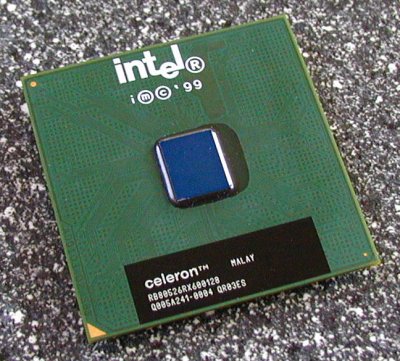Performance Guide: Intel Celeron
Introduction
Almost two years ago, in August 1998, Intel introduced the Celeron processor based on the popular Mendocino core. Its predecessor (Covington) came with the Pentium II Deschutes core, but without using any L2 cache memory. That's why the first generation Celeron processors were rather slow and unsuccessful. On March 29 of this year, Intel introduced two more Celeron processors, clocked at 566 and 600 MHz. These new models are equipped with Intel's latest core (Coppermine) but come with only 128 kBytes of full speed L2 cache (instead of the Pentium III's 256 kBytes), making them really interesting again. Moreover, all new Celeron CPUs also include Intel's SSE extensions. With applications supporting this proprietary standard, you will get some extra performance.
As you can read in the review of the AMD Duron processor , the Celeron cannot hold up to its competition from AMD. Nevertheless, lots of users have been thinking about getting a new Celeron CPU (533A or faster), as it was believed to run at 100 MHz FSB just as well. Now some users are speculating on getting a fast Celeron processor. Even though the Celeron is still officially limited to 66 MHz and its main competitor, the Duron, is considerably faster, it is still an inexpensive and fast processor. Moreover, Celeron is best suited for upgrading and overclocking.
66 MHz System Speed
As a low cost product, the Celeron is of course not supposed to reach Pentium III performance. To ensure this, Intel limits its L2 cache to 128 kBytes and its FSB to only 66 MHz. Nevertheless, most Celeron CPUs can be overclocked to 75 or 83 MHz, resulting in a core clock as well nas performace icrease of 13% (75 MHz) or 26% (83 MHz). It is sometimes even possible to run some CPUs at 100 MHz system clock, resulting in a 50% higher core clock speed!
Usually, you will be able to get the Celerons between 300A and 466 MHz running at 92 - 100 MHz FSB, giving you an even more excellent price/performance ratio. The new Celerons 533A and 566 turn out to be able coping with up to 100 MHz system speed as well, getting their core speed up to 800 and 850 MHz.
66 MHz system speed is not going to be a real disadvantage, as the performance of mid-class Celeron CPUs is still sufficient for most applications. As a matter of fact, it is still the graphics card that prevents us from being able to enjoy high resolutions. Please take a look at the CPU scaling benchmarks of Tom's GeForce 2 GTS review. It makes quite clear that a Celeron is still fast enough for most games. As long as the fill rate or memory bandwidth of a graphics card is the bottleneck, people with low budget should spend their money in a fast graphics card rather than in a CPU. Please read Tom's article about 3D benchmarking to learn more about this topic.
Celeron Vs. Pentium III
Computers are fast becoming as normal as televisions today, which is why you often can find several ones in today's households. In recent times, the Internet was of course the main contributor to this evolvement. Lots of our readers are business people, computer freaks or individuals dealing with computers as a hobby. But a large part of today's users cannot or simply do not want to spend $2000 on a PC. That's why the low-end market has been growing considerably over the last years. And it is also the main reason why Intel is offering a declared low-end CPU like their Celeron. AMD was able to sell huge amounts of K6, K6-2 and K6-III processors, even though they had never been a threat to Intel's high performance products. The sales volumes of low end processors cannot be justified by their great performance, but by the fact that these chips provide enough performance for non-3D applications like word processing, spread sheets, presentations, webdesign and similar software.
The Celeron does not differ very much from its big brother, the Pentium III, but there is one safe way - besides the labeling - to distinguish them:
Get Tom's Hardware's best news and in-depth reviews, straight to your inbox.
The left processor is the Pentium III. It comes with more capacitors.

Patrick Schmid was the editor-in-chief for Tom's Hardware from 2005 to 2006. He wrote numerous articles on a wide range of hardware topics, including storage, CPUs, and system builds.


